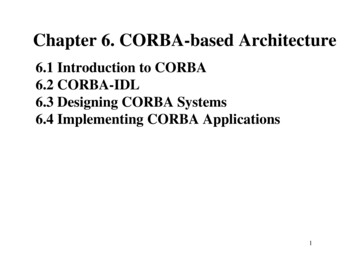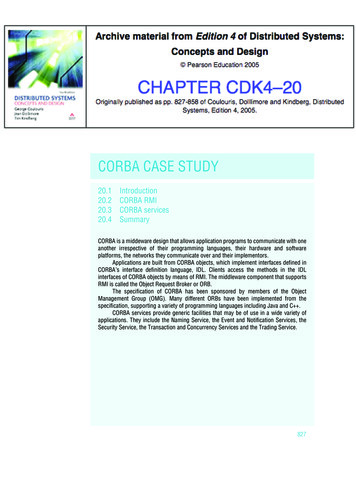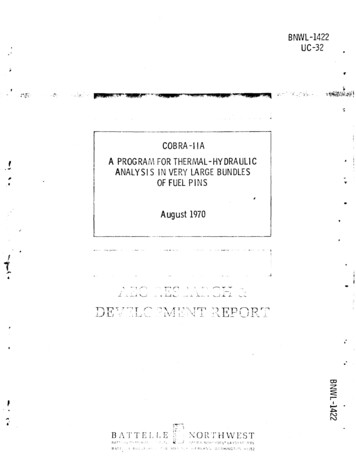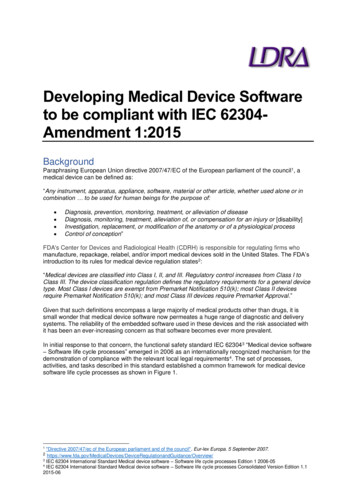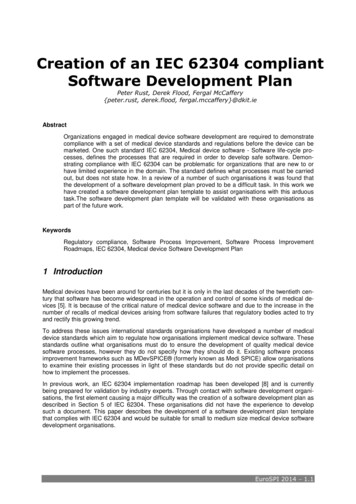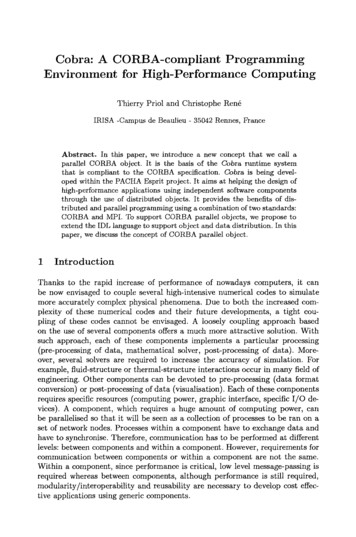
Transcription
Cobra: A CORBA-compliant ProgrammingEnvironment for High-Performance ComputingThierry Priol and Christophe Ren IRISA -Campus de Beaulieu - 35042 Rennes, PranceA b s t r a c t . In this paper, we introduce a new concept that we call aparallel COtlBA object. It is the basis of the Cobra runtime systemthat is compliant to the CORBA specification. Cobra is being developed within the PACHA Esprit project. It aims at helping the design ofhigh-performance applications using independent software componentsthrough the use of distributed objects. It provides the benefits of distributed and parallel programming using a combination of two standards:CORBA and MPI. To support CORBA parallel objects, we propose toextend the IDL language to support object and data distribution. In thispaper, we discuss the concept of CORBA parallel object,1IntroductionThanks to the rapid increase of performance of nowadays computers, it canbe now envisaged to couple several high-intensive numerical codes to simulatemore accurately complex physical phenomena. Due to both the increased complexity of these numerical codes and their future developments, a tight coupling of these codes cannot be envisaged. A loosely coupling approach basedon the use of several components offers a much more attractive solution. Withsuch approach, each of these components implements a particular processing(pre-processing of data, mathematical solver, post-processing of data). Moreover, several solvers are required to increase the accuracy of simulation. Forexample, fluid-structure or thermal-structure interactions occur in m a n y field ofengineering. Other components can be devoted to pre-processing (data formatconversion) or post-processing of d a t a (visualisation). Each of these componentsrequires specific resources (computing power, graphic interface, specific I / O devices). A component, which requires a huge amount of computing power, canbe parallelised so t h a t it will be seen as a collection of processes to be ran on aset of network nodes. Processes within a component have to exchange d a t a andhave to synchronise. Therefore, communication has to be performed at differentlevels: between components and within a component. However, requirements forcommunication between components or within a component are not the same.Within a component, since performance is critical, low level message-passing isrequired whereas between components, although performance is still required,modularity/interoperability and reusability are necessary to develop cost effective applications using generic components.
1115However, till now, low level message-passing libraries, such as MPI or PVM,are used to couple codes. It is obvious to say that this approach does not contribute to the design of applications using independent software components.Such communication libraries were developed for parallel programming so thatthey do not offer the necessary support for designing components which canbe reused by other applications. Solutions already exist to decrease the designcomplexity of applications. Distributed object-oriented technology is one of thesesolutions. A complex application can be seen as a collection of objects, which represent the components, running on different machines and interacting togetherusing remote object invocations. Existing standard such as CORBA (CommonObject Request Broker Architecture) aims at helping the design of applicationsusing independent software components through the use of CORBA objects 1CORBA is a distributed software platform which supports distributed objectcomputing. However, exploitation of parallelism within such object is restrictedin a sense that it is limited to a single node within a network. Therefore, bothparallel and distributed programming environments have their own limitationswhich do not allow, alone, the design of high performance applications using aset of reusable software components.This paper aims at introducing a new approach that takes advantage ofboth parallel and distributed programming systems. It aims at helping programmers to design high performance applications based on the assembling ofgeneric software components. This environment relies on CORBA with extensions to support parallelism across several network nodes within a distributedsystem. Our contribution concerns extensions to support a new kind of objectwe called a parallel CORBA object (or parallel object) as well as the integration of message-passing paradigms, mainly MPI, within a parallel object. Theseextensions exploit as much as possible the functionality offered by CORBA andrequires few modifications to existing CORBA implementations. The paper isorganised as follows. Section 2 gives a short introduction to CORBA. Section3 describes our extensions to the CORBA specification to support parallelismwithin an object. Section 4 introduces briefly the Cobra runtime system for theexecution of parallel objects. Section 5 describes some related works that sharesome similarities with our own work. Finally, section 6 draws some conclusionsand perspectives.2A n o v e r v i e w of C O R B ACORBA is a specification from the OMG (Object Management Group) [5] tosupport distributed object oriented applications. Such applications can be seenas a collection of independent software components or CORBA objects. Objects have an interface that is used to describe operations that can be remotelyinvoked. Object interface is specified using the Interface Definition Language(IDL). The following example shows a simple IDL interface:1 For the remaining of the paper, we will use simply object to name a CORBA object
1116interface myservice {void put(in double a);double myop(inout long i, out long j);};An interface contains a list of operations. Operations may have parameterswhose types are similar to C ones. A keyword added just before the typespecifies whether the parameter is an input or an output parameter or both.IDL provides an interface inheritance mechanism so that services can be extended easily. Figure 1 provides a simplified view of the CORBA architecture.CORBA Object ''", .,,( :1IObject9I"9i'!l Implementation l I: rI" . . . . - - " O b i e c t RequesiBrok-er . . . . . . . . ]"Fig. 1. CORBA system architectureIn this figure, an object located at the client side is bound to an implementationof an object located at the server side. When a client invokes an operation, communication between the client and the server is performed through the ObjectRequest Broker (ORB) thanks to the IDL stub (client side) and the 1DL skeleton (server side). Stub and skeleton are generated by an IDL compiler takingas input the IDL specification of the object. A CORBA compliant system offersseveral services for the execution of distributed object-oriented applications. Forinstance, it provides object registration and activation.3ParallelCORBAobjectCORBA was not originally intended to support parallelism within an object.However, some CORBA implementations provide a multi-threading support forthe implementation of objects. Such support is able to exploit simultaneouslyseveral processors sharing a physical memory within a single computer. Suchlevel of parallelism does not require modification of the CORBA specificationsince it concerns only the object implementation at the server side. Instead ofhaving one thread assigned to an operation, it can be implemented using severalthreads. However, the sharing of a single physical memory does not allow a large
1117number of processors since it could create memory contention. One objective ofour work was to exploit several dozen of nodes available on a network to carryout a parallel execution of an object. To reach this objective, we introduce theconcept of parallel CORBA object.3.1Execution modelServer 1Parallel server nodeServer n, g - .' , i t Process I'!qr"i IObject!i[ ImplementationClientnodei.l-'-I . ?L IISkeletonl',',*'I'IObject,Implementation Ill II',I .IDL II b,',',I'l', CORBA object collection1iIh'',,j[Process Jparallel CORBAobject,',l','uJ"Fig. 2. Parallel CORBA object service execution model.The concept of parallel object relies on a SPMD (Single Program Multiple Data)execution model which is now widely used for programming distributed memoryparallel computers. A parallel object is a collection of identical objects havingtheir own data so that it complies with the SPMD execution model. Figure 2 illustrates the concept of parallel object. From the client side, there is no differencewhen calling a parallel object comparing to a standard object. Parallelism is thushidden to the user. When a call to an operation is performed by a client, suchoperation is executed by all CORBA objects belonging to the collection. Suchparallel execution is handled by the stub that is generated by an Extended-IDLcompiler, which is a modified version of the standard IDL compiler.3.2Extended-IDLAs for a standard object, a parallel object is associated with an interface thatspecifies which operations are available. However, this interface is described usingan IDL we extended to support parallelism. Extensions to the standard IDL aimat both specifying that an interface corresponds to a parallel object and atdistributing parameter values among the collection of objects. Extended-IDL isthe name of these extensions.
1118S p e c i f y i n g t h e d e g r e e o f p a r a l l e l i s m The first IDL extension corresponds tothe specification of the number of objects of the collection that will implementthe parallel object. Modifications to the IDL language consist in adding twobrackets to the IDL interface keyword. A parameter can be added within thetwo brackets to specify the number of objects belonging to the collection. Suchparameter can be a "*", that means that the number of objects belonging to thecollection is not specified in the interface. The following example illustrates theproposed extension.interface [*] ComputeFEM {typedef double dmat [I00] [I00] ;void initFEM(in dmat mat, in double p) ;void doFEM(in long niter, out double err) ;};In this example, the number of objects will be fixed at runtime dependingon the available resources (i.e. the number of network nodes if we assume thateach object of the collection is assigned to only one node). The implementationof a parallel object may require a given number of objects in the collection tobe able to run correctly. Such number may be inserted within the two bracketsof the proposed extension. The following example gives an example of a parallelobject service which is made of 4 objects.interface[4] ComputeFgM {};Instead of giving a fixed number of objects in the collection, a function maybe added to specify a valid number of objects in the collection. The followingexample illustrates such possibility. In that case, the number of objects in thecollection may be only a power of 2.interface [n 2] ComputeFEM {};It is the responsibility of the runtime system, in our case Cobra, to checkwhether the number of network nodes has been allocated according to the specification of the parallel object. IDL allows a new interface to inherit from anexisting one. Parallel interface can do the same but with some restrictions. Aparallel interface can inherit only from an existing parallel interface. Inheritancefrom standard interface is forbidden. Moreover, inheritance is allowed only forparallel interfaces that could be implemented by a collection of objects for whichthe number of objects coincides. The following example illustrates this restriction.interface [*] MatrixComponent{};interface In 2] ComputeFEM: MatrixComponent{
1119In this example, interface ComputeFEM derives from interface MatrixComportent, The new interface has to be implemented using a collection having apower of 2 objects. In the following example, the Extended-IDL compiler willgenerate an error when compiling because inheritance is not valid :interface[3] MatrixComponent{};interface In'2] ComputeFEM: MatrixComponent{};S p e c i f y i n g d a t a d i s t r i b u t i o n Our second extension to the IDL language concerns d a t a distribution. The execution of a method on a client side will provokethe execution of the method on every objects of the collection. Since, each object of the collection has it own separate address space, we m u s t envisage howto distribute p a r a m e t e r values for each operation. Attributes and types of operation parameters act on the data distribution. Proposed extension of IDL ford a t a distribution is allowed only for parameters of operations defined in a parallel interface. When a standard IDL type is associated with a p a r a m e t e r withan in mode, each object of the collection will receive the same value. When ap a r a m e t e r of an operation has either an o u t or a i n o u t mode, as a result of theexecution of the operation, stub generated by the Extended-IDL compiler willget a value from one of the objects of the collection.T h e IDL language provides multidimensional fixed-size arrays which containselements of the same type. The size along each dimension has to be specified inthe definition. We provide some extensions to allow the distribution of arraysamong the objects of a collection. D a t a distribution specifications apply for b o t hin, o u t and i n o u t mode. They are similar to the ones already defined by H P F(High Performance Fortran). The following example gives a brief overview of theproposed extension.interface[*] MatrixComponent {typedef double dmat [iO0] [I00] ;typedef double dvec[iO0];void matrix vector mult (in dist [BLOCK] [*] dmat, in dvec v,out dist[CYCLIC] dvec u);};This extension consists in the adding of a new keyword (dist) which specifieshow an array is distributed among the objects of the collection. For example, the2D array m a t is distributed by block of rows. Stubs generated by the ExtendedIDL compiler do not perform the same work when the p a r a m e t e r is an inputor an output parameter. With an input parameter, the stub must scatter thedistributed array so that each object of the collection received a subset of thewhole array. With an output parameter, the stub must do the reverse operation.Indeed, each object of a collection contains a subset of the array. Therefore,the stub is in charge of gathering d a t a from objects belonging to the collection.
1120Such gathering may include a redistribution of data if the client is itself a parallel object. In the previous example, the number of objects in the collection isnot specified in the interface. Therefore, the number of elements assigned to aparticular object can be known only at runtime. It is why a distributed arrayof a given IDL type is mapped to an unbounded sequence of this IDL type.Unbounded sequence offers the advantage that its length is set up at runtime.We propose to extend the sequence structure to store information related to thedistribution.4A runtime s y s t e m to support parallel C O R B A objectsThe Cobra runtime system [2] aims at providing resource allocation for the execution of parallel objects. It is targeted to a network of PCs connected togetherusing SCI [6]. Resource allocation consists in providing network nodes and sharedvirtual memory regions for the execution of parallel objects. Resource allocationservices are performed by the resource management service (RmProcess) of Cobra. It is used when a parallel service must be bind to a client. We propose toextend the bind method provided by most of the CORBA implementations.Binding to a parallel object differs from the standard binding method. Indeed, areference to a virtual parallel machine ( v p m ) is given as an argument of the bindmethod instead of a single machine. The v p m reference is obtained through theCobra resource allocator. The following example illustrates how to use a parallelobject service within the Cobra runtime:// Obtain a reference from the RmProcess servicecobra RmProcess:: bind("cobra.irisa.fr");// Create a VPMcobra- mkvpm(vpmname, NumberOfNodes, NORES);// Get a reference to the allocated vpmpap get info vpm( vpm, vpmname);// Obtain a reference from the parallel object service: MatrixComponentcs MatrixComponent:: bind ( &vpm );// Invoke an operation provided by MatrixComponent servicecs- matrix vector mult( a, b, c);The bind method may be called either by a single object, or by all objectsbelonging to a collection if the client is itself a parallel object.5Related worksSeveral projects deal with environments for high-performance computing combining the benefits of distributed and parallel programming. The RCS [1], NetSolve [3] and Ninf [8] projects provide an easy way to access linear algebramethod libraries which run on remote supercomputer. Each method is described
1121by a specific interface description language. Clients invoke methods thanks tospecific functions. Arguments of these functions specify method name and m e t h o darguments. These projects propose some mechanisms to manage load balancingon different supercomputers. One drawback of these environments is the difficulty for the user to add new functions in the libraries. Moreover, they are notcompliant to relevant standard such as CORBA. The Legion [4] project aimsat creating a world wide environment for high-performance computing. A lot ofprinciples of CORBA (such as heterogeneity management and object location)are provided by the Legion run-time, although Legion is not CORBA-eompliant.It manipulates parallel objects to obtain high-performance. All these features arein common with our Cobra run-time. However, Legion provides others servicessuch as load balancing on different hosts, fault-tolerance and security which arenot present in Cobra. The PARDIS [7] project proposes a solution very close toour approach because it extends the CORBA object model to a parallel objectmodel. A new IDL type is added: c/sequence (for distributed sequence). It is ageneralisation of the COI BA sequence. This new sequence describes data type,data size, and how data must be distributed among objects. In PARDIS, distribution of objects is let to the programmers. It is the main difference with Cobrafor which a resource allocator is provided. Moreover in Cobra, extended-IDLallows to describe object parallel services in more details.6ConclusionandperspectivesThis paper introduced the parallel CORBA object concept. It is a collection ofstandard CORBA objects. Its interface is described using an Extended-IDL tomanage data distribution among the objects of the collection. Cobra is being implemented using Orbix from Iona Tech. It has already been tested for building asignal processing application using a client/server approach [2]. For such application, the most computing part of the application is encapsulated within a parallelCORBA object while the graphical interface is a Java applet. This applet, acting as a client, is connected to the server through the CORBA ORB. Currentworks are now focusing on the experiment of the coupling of numerical codes.Particular attention will be paid on the performance of the ORB which seems tobe the most critical part of the software environment to get the requested performance. It is planned, within the PACHA project, to implement an ORB thatfully exploits the performance of the SCI clustering technology while ensuringcompatibility with existing ORB through standard protocols such as T C P / I P .References1. P. Arbenz, W. Gander, and M. Oettli. The Remote Computation System. In HPCNEurope '96, volume 1067 of LNCS, pages 662-667, 1996.2. P. Beaugendre, T. Priol, G. Alleon, and D. Delavaux. A client/server approach forhpc applications within a networking environment. In HPCN'98,
Cobra is being devel- oped within the PACHA Esprit project. It aims at helping the design of high-performance applications using independent software components through the use of distributed objects. It provides the benefits of dis- tributed and parallel programming using a combination of two standards: CORBA and MPI.Cited by: 32Publish Year: 1998Author:
